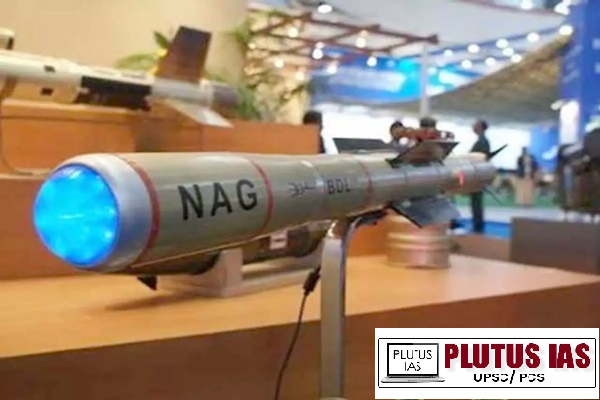28 Mar India Strengthens Defence Might with Nag Missile System Procurement
This article covers “Daily Current Affairs” and the Topic of “India Strengthens Defence Might with Nag Missile System Procurement.”
SYLLABUS MAPPING:
GS-3-Science and Technology- India Strengthens Defence Might with Nag Missile System Procurement
FOR PRELIMS
What is a Nag Missile? What are the key challenges India faces in achieving self-reliance in defence technology?
FOR MAINS
What challenges does India face in becoming self-reliant in defence technology?
Why in the News?
What is a Nag Missile?
The Nag Missile (meaning “Cobra” in Sanskrit) is an Indian third-generation, fire-and-forget, anti-tank guided missile (ATGM) developed by the Defence Research and Development Organisation (DRDO) under the Integrated Guided Missile Development Program (IGMDP). It is designed to destroy heavily armoured enemy tanks and other military vehicles.
key features of Nag Missile
1. Fire-and-Forget Technology: Uses an Imaging Infrared (IIR) seeker to autonomously track and destroy targets without requiring further input from the operator.
2. Tandem-Charge Warhead: Equipped with a high-explosive anti-tank (HEAT) warhead capable of penetrating the Explosive Reactive Armor (ERA) of modern tanks.
3. Multiple Variants: Includes NAMICA (land-based), HELINA (air-launched), MPATGM (man-portable), and a millimetric-wave (mmW) seeker version for enhanced tracking.
4. All-Weather, Day & Night Capability: Can function in extreme weather conditions, including deserts, fog, and low-visibility scenarios.
5. High Accuracy & Hit Probability: Achieves a 90% single-shot hit probability, ensuring high effectiveness on the battlefield.
6. Multiple Attack Modes: Can execute Top-Attack (penetrating the weaker top armour of tanks) and Direct Attack modes for flexible engagement strategies.
7. Extended Operational Range: Land-based variant has a range of 500 meters to 4 km, while the helicopter-launched version (HELINA) extends up to 7-10 km.
8. Advanced Guidance System: Uses real-time image processing, CCD camera integration, and digital autopilot for improved tracking and accuracy.
9. Multiple Launch Platforms: Can be launched from NAMICA (Nag Missile Carrier), helicopters (HELINA/Dhruvastra), and future air-launched platforms.
Govt. Initiative to promote self-resilience in defence technology
1. Aatmanirbhar Bharat in Defence: 75% of ₹1 lakh crore defence budget reserved for domestic procurement in 2023-24.
2. Defence Acquisition Procedure (DAP) 2020: Prioritizes Indigenously Designed, Developed, and Manufactured (IDDM) products & simplifies private sector entry.
3. Positive Indigenisation Lists: 509 defence items (missiles, UAVs, helicopters) were banned from import to boost local production.
4. Defence Industrial Corridors (DICs): ₹20,000+ crore investment in Tamil Nadu & UP, fostering 150+ defense industries.
5. Make in India & Make-II: Encourages local manufacturing & private sector involvement in defence production.
6. Innovations for Defence Excellence (iDEX): ₹500 crore fund to support 300+ startups in AI, drones, and robotics.
7. FDI Policy in Defence: FDI limit raised to 74% (automatic) and 100% (with approval), boosting foreign investment & tech transfer.
8. Defence Exports: India’s defense exports hit ₹16,000 crore in 2022-23, targeting ₹35,000 crore by 2025.
9. Corporatisation of Ordnance Factories: OFB restructured into 7 PSUs for efficiency in ammunition & arms production.
10. Strategic Partnership Model (SPM): Enables Indian firms & foreign defence giants to co-develop jets, submarines, & helicopters.
What are the Challenges in self-resilience in defence technology?
1. Dependence on Foreign Technology: High reliance on imports for critical components like jet engines, radars, and semiconductors.
2. Limited R&D & Innovation: Low defence R&D spending (less than 1% of GDP), with slow private sector participation.
3. Complex Procurement Process: Bureaucratic delays and regulatory hurdles slow down Indigenous defence projects.
4. Weak Defence Manufacturing Ecosystem: Lack of advanced infrastructure and specialized suppliers for high-tech weapons.
5. Insufficient Private Sector Involvement: Large defence PSUs dominate, limiting opportunities for private companies and startups.
6. Skilled Workforce Shortage: Need for more experts in AI, cyber warfare, aerospace, and missile technology.
7. High Cost & Long Development Time: Indigenous projects like Tejas Arjun Tank took decades, increasing costs and delays.
8. Limited Export Competitiveness: Indian defence products struggle to compete globally due to technology gaps and quality concerns.
9. Cybersecurity & AI Risks: Growing threats of cyber warfare and AI-based attacks require stronger indigenous digital defence systems.
Way forward
1. Boost R&D Investment: Increase defence R&D spending (currently <1% of GDP) and promote indigenous innovation through DRDO, academia, and private sector collaboration.
2. Strengthen Defence Manufacturing: Develop a robust domestic supply chain for critical components like jet engines, semiconductors, and avionics to reduce import dependence.
3. Faster Procurement & Policy Reforms: Simplify bureaucratic procedures, ensure time-bound approvals, and promote Make in India through Defence Acquisition Procedure (DAP) 2020.
4. Encourage the Private Sector & Startups: Provide financial incentives, ease FDI norms (currently 74% under automatic route), and foster startups under iDEX (Innovations for Defence Excellence).
5. Focus on Emerging Technologies: Invest in AI, cyber warfare, quantum computing, and hypersonic weapons to build next-gen defence capabilities.
6. Improve Skilling & Talent Development: Strengthen technical education, R&D institutions, and industry-academia collaborations to build a skilled workforce.
7. Enhance Defence Exports: Achieve the target of $5 billion in defence exports by 2025 by promoting Indian-made weapons, missiles, and aircraft in global markets.
8. Public-Private Partnerships (PPP): Strengthen collaboration between DRDO, DPSUs, and private firms to accelerate indigenous development.
Q. With reference to the Nag Missile System (NAMIS), consider the following statements:
1. It is an anti-tank guided missile (ATGM) developed by DRDO under the Integrated Guided Missile Development Program (IGMDP).
2. The Nag missile uses a semi-active laser-homing guidance system.
Which of the statements given above is/are correct?
A. 1 only
B. 2 only
C. Both 1 and 2
D. Neither 1 nor 2
Answer: A
Mains Questions
Q. Discuss the significance of the Nag Missile System (NAMIS) in strengthening India’s defence capabilities. (250 words, 15 marks)





No Comments